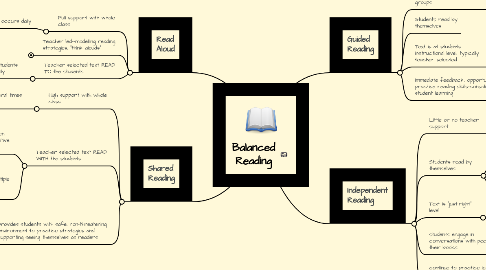
1. Read Aloud
1.1. Full support with whole class
1.1.1. occurs daily
1.2. Teacher led--modelling reading strategies, "think alouds"
1.2.1. Project specifications
1.2.2. End User requirements
1.2.3. Action points sign-off
1.3. Teacher selected text READ TO the students
1.3.1. Book beyond what students can read independently
2. Shared Reading
2.1. High support with whole class
2.1.1. occurs daily or several times a week
2.2. Teacher selected text READ WITH the students
2.2.1. Students encouraged to join in when comfortable use of familiar, repetitive text
2.2.1.1. Kindergarten Example: Brown Bear, Brown Bear What do you see?
2.2.1.2. Choose to retell the story using pictures of characters and "choral read" the repetitive phrasing
2.2.2. big book or chart paper or multiple copies may be available for all students
2.3. provides students with safe, non-threatening environment to practice strategies and supporting seeing themselves as readers
2.3.1. Build book and print awareness in K-Gr 1 by modelling reading behaviours, such as reading left-right, top-bottom
2.3.2. Build book and print awareness in K-Gr 1 by modelling reading behaviours, such as reading left-right, top-bottom
3. Guided Reading
3.1. Support as needed with small groups
3.1.1. occurs regularly during week based on student need
3.2. Students read by themselves
3.3. Text is at students instructional level, typically teacher selected
3.3.1. Teaching what's important through Sticky note summaries-students write a summary sentence at the end of a section of the text
3.4. immediate feedback, opportunities to use and practise reading skills-consolidation of student learning
4. Independent Reading
4.1. Little or no teacher support
4.1.1. occurs daily sometimes called silent reading or DEAR = Drop Everything And Read
4.2. Students read by themselves
4.2.1. Teacher conducts individual student conferences
4.2.2. students at desks or scattered amongst classroom
4.2.2.1. silent or whisper voices
4.3. Text is "just-right" level
4.3.1. student choice-source of interest, pleasure and information
4.4. students engage in conversations with peers about their books
4.4.1. Activity: quick meeting of reading partners to build comprehension & oral language...where they ask questions of their partner about what was read during IR. Choose from list or dice of reading response prompts or use
